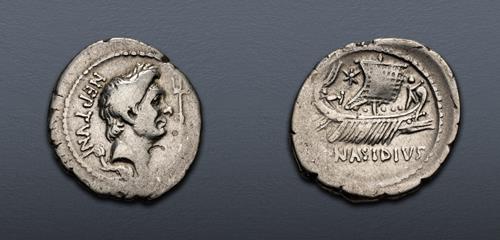
|
The Pompeians. Sextus Pompey. 42-38 BC. AR Denarius (21mm, 3.56 g, 11h). Massilia (Marseilles) mint; Q. Nasidius, commander of the fleet.
Electronic Auction 516
Lot: 472. Estimated: $ 1 000
Roman Republican, Silver
Sold For $ 1 300. This amount does not include the buyer’s fee.
Go to Live
|
|
The Pompeians. Sextus Pompey. 42-38 BC. AR Denarius (21mm, 3.56 g, 11h). Massilia (Marseilles) mint; Q. Nasidius, commander of the fleet. Bare head of Pompey the Great right; trident to right; below, dolphin right / Galley with bank of rowers right, under full sail, helmsman steering rudder, hortator standing on prow; star to upper left. Crawford 483/2; CRI 235; Sydenham 1350; RSC 20 (Pompey the Great); RBW 1698. Minor scratches, banker’s marks on obverse. Near VF.
From the Dean Kinzer Collection, purchased from Edgar L. Owen.
Sextus Pompey came of age during the ascendancy of his father, Gnaeus Pompeius Magnus (Pompey the Great), as the leading general of Rome and the most powerful man in the Republic. After Pompey’s defeat by Julius Caesar at Pharsalus in August of 48 BC, and his treacherous murder in Egypt later that year, Sextus joined the Pompeian resistance to Caesar in Spain. Caesar’s assassination on March 15, 44 BC brought a brief revival of Senatorial control, during which Sextus relocated to Massalia in southern Gaul. In April of 43 BC, the Senate appointed him commander of the Roman fleet. Although the promotion was rescinded three months later, Sextus wasted no time in seizing Sicily and spent the next months building an impregnable power base on the island even as Rome fell under the sway of Caesar’s political heirs, the Triumvirs Antony, Octavian and Lepidus.
This denarius belongs to the brief interval between Caesar’s murder and Sextus’ appointment as Praefect of the Fleet, during his sojourn at the Gallic port city of Massilia. The obverse portrait is clearly recognizable as Pompey the Great, although the legend identifies him as “son of Neptune” (an epithet won by Magnus after his defeat of the Cilician Pirates, and later claimed by Sextus himself) and provides him appropriate attributes - a dolphin and trident. The warship on the reverse appears to be a hemiola, a fast ramming vessel with two banks of oars totaling 52 a side. Interestingly, Sextus himself is not named; instead the moneyer is identified as Quintus Nasidius, a loyal Pompeian commander of naval forces who backed Sextus in his early career, only to later defect to Mark Antony.
Closing Date and Time: 18 May 2022 at 12:37:00 ET.
All winning bids are subject to an 18% buyer’s fee.
|
